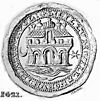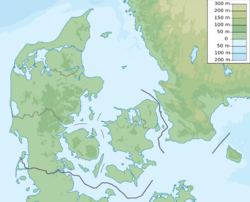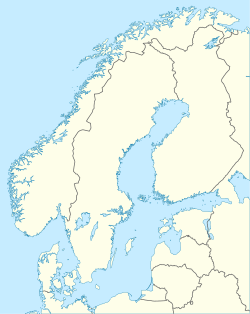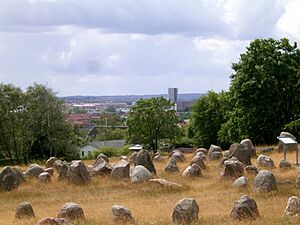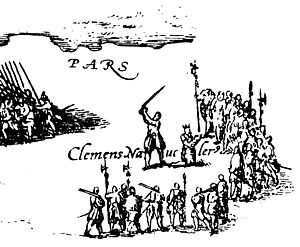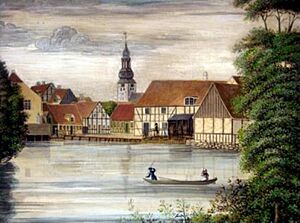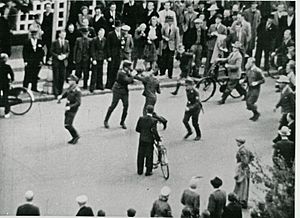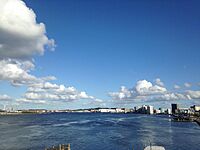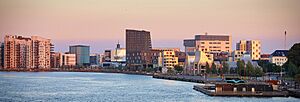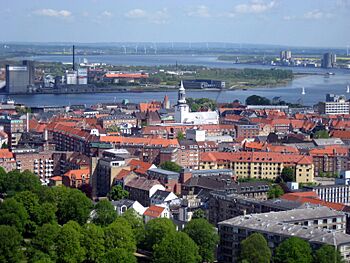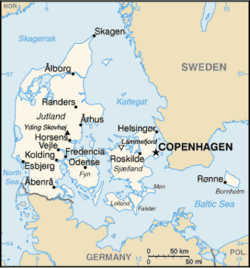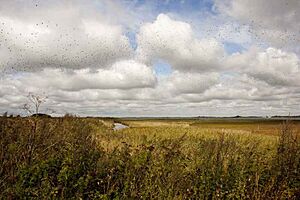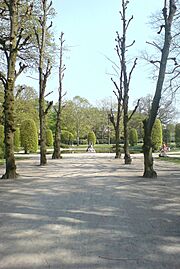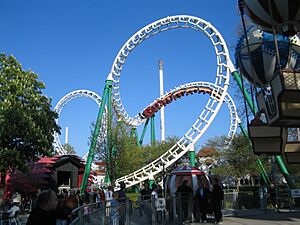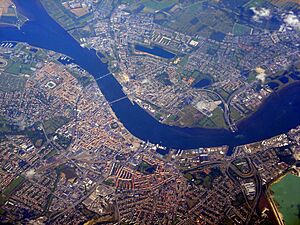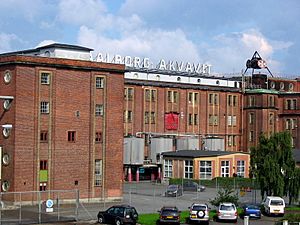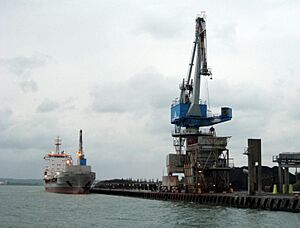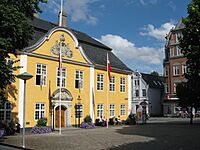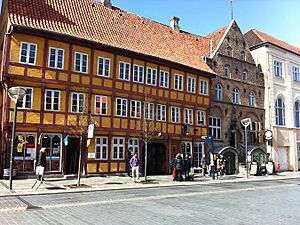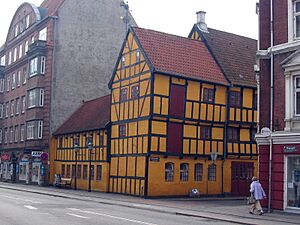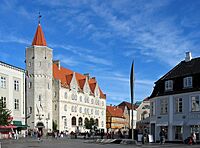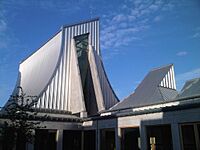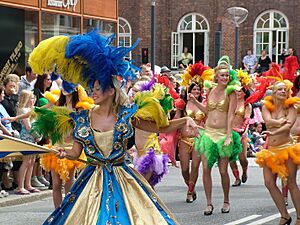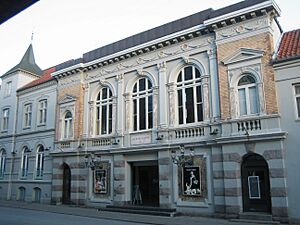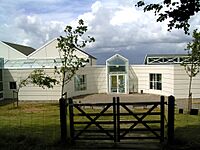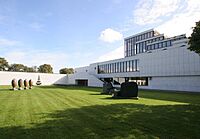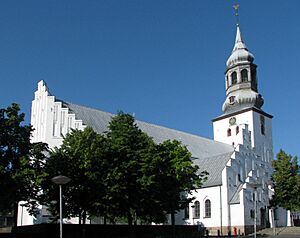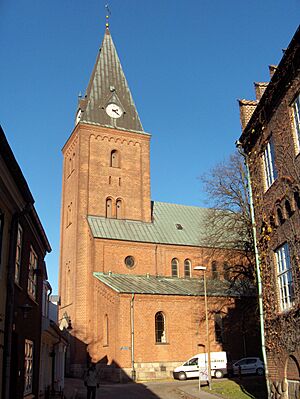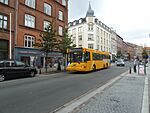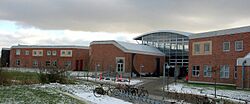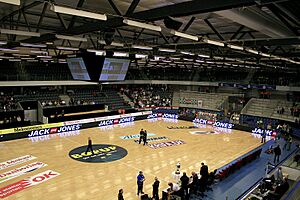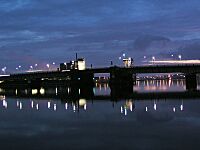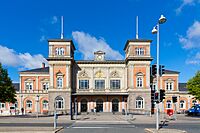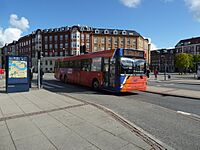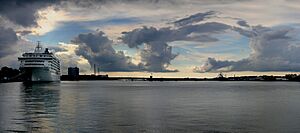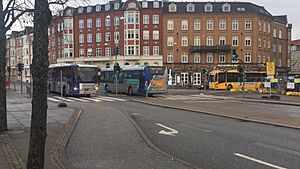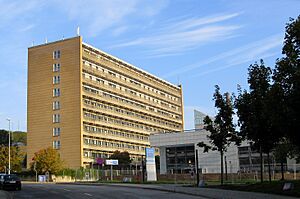Aalborg facts for kids
Quick facts for kids
Aalborg
Ålborg
|
|||
|---|---|---|---|
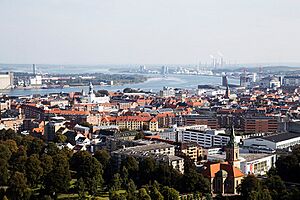
Panoramic view of Aalborg (September 2018)
|
|||
|
|||
| Nicknames:
"Paris of the North", locally "Double A"
|
|||
| Country | |||
| Region | North Jutland Region | ||
| Municipality | Aalborg | ||
| First mention | "Alabu" written on coins c. 1035 | ||
| Official establishment | 16 June 1342 | ||
| Area | |||
| • City | 50.70 km2 (19.58 sq mi) | ||
| • Urban | 61.30 km2 (23.67 sq mi) | ||
| • Metro | 7,883.70 km2 (3,043.91 sq mi) | ||
| • Municipal | 1,137.3 km2 (439.1 sq mi) | ||
| Elevation | 55 m (180 ft) | ||
| Population
(2022)
|
|||
| • City | 119,862 | ||
| • Density | 2,364.14/km2 (6,123.1/sq mi) | ||
| • Urban | 143,598 | ||
| • Urban density | 2,342.54/km2 (6,067.2/sq mi) | ||
| • Metro | 594,323 | ||
| • Metro density | 75.39/km2 (195.3/sq mi) | ||
| • Municipality | 221,082 | ||
| • Municipality density | 194.39/km2 (503.5/sq mi) | ||
| Demonym(s) | Aalborgenser | ||
| Time zone | UTC+1 (Central Europe Time) | ||
| • Summer (DST) | UTC+2 | ||
| Postal codes |
9000, 9008, 9020, 9100, 9200, 9210, 9220, 9400
|
||
| Area code(s) | (+45) 9 | ||
Aalborg or Ålborg is a big city in Denmark. It is the fourth largest city in the country. About 119,862 people live in the city itself. If you count the wider urban area, it has 143,598 residents. The whole Aalborg area is home to 221,082 people. This makes it the third most populated municipality in Denmark.
Aalborg is about 64 kilometers (40 miles) southwest of Frederikshavn. It is 118 kilometers (73 miles) north of Aarhus. To reach Copenhagen, it's a longer trip of 412 kilometers (256 miles) by road.
The first settlements here were around the year 700. Aalborg became an important harbor in the Middle Ages. This was because it was located at the narrowest part of the Limfjord. Later, it grew into a large industrial center. Many old buildings in the city are half-timbered mansions. These were built by rich merchants long ago. Budolfi Church, now a cathedral, was built in the late 1300s. Aalborghus Castle, a royal home, was built in 1550.
Today, Aalborg is changing. It's moving from being an industrial city to a place focused on knowledge and culture. It exports things like grain, cement, and drinks. Big companies like Siemens Gamesa Renewable Energy and Aalborg Portland are here. They make things like wind turbine parts and cement for the world.
Aalborg is also a major cultural spot. It has theaters, a symphony orchestra, and museums. The Aalborg Carnival in May is one of the biggest festivals in Scandinavia. It attracts over 100,000 people every year. The main university is Aalborg University (AAU), founded in 1974. It has more than 20,000 students. Aalborg University Hospital, the biggest hospital in northern Jutland, opened in 1881.
The local football club, Aalborg BK, has won the Danish Superliga four times. Other sports teams include the ice hockey club Aalborg Pirates and the handball team Aalborg Håndbold. Aalborg Railway Station connects the city to other parts of Denmark. Aalborg Airport is just 6 kilometers (4 miles) from the city center. The E45 highway also passes through Aalborg.
A survey in 2014 found that people in Aalborg are the most satisfied with their city in all of Europe!
Contents
Name
The name Aalborg comes from old coins from the 1000s. It was spelled Alabu or Alabur back then. There has been a debate about how to spell the city's name. Today, it's almost always written with "aa" instead of the Danish letter "å". The letter "å" was supposed to replace "aa" in all Danish place names in 1948.
However, Aalborg's city council decided to keep the old spelling. They said the city was known worldwide as "Aalborg". In 1984, the government allowed cities to choose their preferred spelling. Both spellings are correct, but locals often prefer "Aalborg". The city is also known as "Dobbelt A" (Double A). It has also been called "Nordens Paris" (Paris of the North).
History
The area around the narrowest part of the Limfjord has been settled for a very long time. A busy Viking community lived here until about the year 1000. In the Middle Ages, Aalborg grew because of royal trading rights, a good harbor, and lots of herring fishing.
Even with challenges over the centuries, the city started to grow again in the late 1800s. This happened when a bridge was built over the Limfjord and the railway arrived. At first, Aalborg grew with heavy industries. Now, it focuses more on culture and education.
Beginnings
Aalborg's history goes back over a thousand years. It started as a trading post because of its location on the Limfjord. You can see the remains of two old settlements and a burial ground at Lindholm Høje. This is a hill overlooking the city. These settlements, one from the 500s and another from the Viking Age (800s to 1000s), grew at the narrowest point of the Limfjord. This was a good spot for travel between Himmerland (south) and Vendsyssel (north).
The first time Aalborg was mentioned was around 1040. It was called Alabu or Alabur on coins from that time. Around 1075, a writer named Adam of Bremen said that Alaburg was an important harbor for ships going to Norway. In an old Danish book from 1231, it was called Aleburgh. This might mean "the fort by the stream."
Middle Ages
Aalborg received its first trading rights in 1342. This was when King Valdemar IV got the town as part of his wife's dowry. The town grew and became one of Denmark's largest communities. Its wealth increased when a merchant group was formed in 1481. This group helped trade with the Hanseatic League.
In 1516, King Christian II gave Aalborg a special right to salt herring from the Limfjord. The king often visited the town and stayed at the old Aalborghus. The herring fishing connected Aalborg to England. During the Middle Ages, important places were built. These included Budolfi Church in the late 1300s and the Hospital of the Holy Ghost in 1451. This hospital helped people in need and is still used today as a nursing home.
In 1530, a big fire destroyed much of the town. In 1534, the king's soldiers attacked and looted the city. This happened after a farmers' revolt led by Skipper Clement. Up to 2,000 people died. The Reformation in 1536 led to the closing of the town's two monasteries. After the Reformation, Aalborg became a Lutheran bishopric in 1554.
17th to 19th Centuries
From the 1550s to the 1640s, Aalborg became very rich. It was second only to Copenhagen in wealth. This was due to more trade with other countries. The city grew, and many beautiful buildings were constructed. In 1663, another serious fire damaged the city.
In the late 1700s, Aalborg became prosperous again. It was called "the best and most prosperous market town in Denmark" after Copenhagen. The population grew from 4,160 in 1769 to 5,579 in 1801. In 1767, Denmark's second newspaper was published here.
After Denmark gave Norway to Sweden in 1814, Aalborg lost its important role in Norwegian trade. The herring industry also faced problems. In the mid-1800s, Aarhus became the largest city in Jutland. However, things improved by the end of the 1800s. A pontoon bridge over the Limfjord was finished in 1865. The railway reached the city in 1869. Aalborg became Denmark's second largest port. It started producing tobacco, spirits, fertilizers, and cement. By 1901, the population was almost 31,500.
20th Century Industrialization
Around the early 1900s, many old half-timbered houses were torn down. Hundreds of modern buildings replaced them, changing the city's look. Factories with smoking chimneys became common. Important factories included those for spirits, textiles, and cement. By the 1930s, Aalborg was known as "Denmark's new center for industry." The port was also improved. In 1933, a new bridge over the Limfjord was opened.
Aalborg Airport opened officially in 1938. During the German invasion of Denmark in 1940, German paratroopers captured the airport. They used it as a base for planes flying to Norway. After the war, the Royal Air Force destroyed the German facilities. By 1960, Aalborg was known as the "city of smoking chimneys." Half of its people worked in factories. By 1970, Aalborg's population reached about 97,000.
Recent History
Aalborg's industries started to decline in the 1970s. This caused the city's population to drop until about 1990. Then, it began to grow again. By 2000, most people worked in service and education. This was partly due to Aalborg University (AAU) opening in 1974. Many small and medium-sized businesses have also started. The telecommunications and IT sectors have grown with help from the university.
In 1994, Aalborg hosted a big conference on sustainable cities. It adopted the Aalborg Charter. This plan helps local areas develop in a way that protects the environment. Another conference in 2004 led to the Aalborg Commitments. These are stronger promises for sustainable development.
On August 10, 2009, a strong tornado hit downtown Aalborg. It caused serious roof damage to many buildings. Trees were snapped and uprooted. The tornado was rated F2 on the Fujita scale.
A 2014 survey by the European Commission found that people in Aalborg are the most satisfied with their city in Europe.
Geography
Aalborg is in North Jutland, in northwestern Denmark. It sits at the narrowest point of the Limfjord. The Limfjord is a shallow sound that separates the North Jutlandic Island from the rest of the Jutland Peninsula. It connects Aalborg to the Kattegat sea about 35 kilometers (22 miles) to the east.
The area near the waterfront is low, about 5 meters (16 feet) above sea level. But there are many hills in and around the city. Some hills are over 60 meters (200 feet) high. Nørresundby, on the north side of the sound, is also hilly.
The City
The city center is very old, dating back to the Middle Ages. It was built on clay banks between two old streams. The main streets, like Algade, still run east to west. Side streets run north to south. Budolfi Church and the old town hall are on Gammeltorv, the old market square. The main shopping streets are Algade and Bispengade. Østerågade, once an old harbor, is famous for its merchant mansions.
The city cemetery, Kildeparken, and the modern art museum, Kunsten, are near the railway station. Hasseris is a residential area with many large houses. The city's main growth area is now to the east. This area has the university, new housing, the shipping harbor, and the cement factory. The waterfront area is changing from a harbor to a fun place. It now has the Utzon Center and Musikkens Hus.
Egholm
Off the city's northwestern side is the island of Egholm. You can reach it by ferry. The island has 51 people living there (as of 2023). It is mostly farmland, but also has some salt marshes and woods. Dikes protect the island from floods. The Kronborg Forest on the island was bought by the city in 1945.
Parks and Green Spaces
The Østre Anlæg park is one of Aalborg's oldest. About 175,000 people visit it each year. It has lawns, flowers, tall trees, and a lake. Fifty-one types of birds have been seen in the park.
Lindholm Fjordpark is part of the city's green areas. It used to be a waste site but was cleaned up. Now it has woodlands and open grassy areas. Many migratory birds, like pale-bellied brent geese, live here. The park is also used for windsurfing and has a six-hole golf course.
Aalborg has other parks and fun places. Kildeparken hosts the yearly Aalborg Carnival. Mølleparken has a pond, statues, and a jogging trail. Sohngårdsholmpark is a wooded area with trails and a free golf course. The Aalborg Open Air Swimming Pool is also free.
The Aalborg Zoo opened in 1935. It has about 1,300 animals from 138 different species. You can see tigers, chimpanzees, elephants, and polar bears. It's a major tourist spot with over 300,000 visitors yearly. The zoo has an African savannah area for exotic animals.
Aalborg used to have an amusement park called Karolinelund. It closed in 2010. Now, it's a leisure area without rides. Volunteers are working to bring it back to life. It hosts seminars, exhibitions, films, and music concerts.
Climate
Aalborg has a maritime climate. This means it has short, mild summers and long, moderately cold winters. Aalborg is cool most of the year. Summer high temperatures are around 20°C (68°F). Lows are about 11°C (52°F). In January and February, the coldest months, temperatures average -3°C to 2°C (27-36°F). It rarely drops below -15°C (5°F). July and August are the warmest months, averaging 16°C (61°F). June has the most sunshine. Rain is spread out throughout the year. October is usually the wettest month, and February is the driest.
Demographics
| Historical population | ||
|---|---|---|
| Year | Pop. | ±% |
| 1672 | 4,181 | — |
| 1787 | 4,866 | +16.4% |
| 1801 | 5,579 | +14.7% |
| 1834 | 7,048 | +26.3% |
| 1845 | 7,477 | +6.1% |
| 1860 | 10,069 | +34.7% |
| 1870 | 11,721 | +16.4% |
| 1880 | 14,152 | +20.7% |
| 1890 | 19,503 | +37.8% |
| 1901 | 31,457 | +61.3% |
| 1911 | 38,415 | +22.1% |
| 1921 | 48,239 | +25.6% |
| 1930 | 59,091 | +22.5% |
| 1940 | 74,681 | +26.4% |
| 1950 | 87,883 | +17.7% |
| 1960 | 96,436 | +9.7% |
| 1970 | 100,587 | +4.3% |
| 1976 | 94,994 | −5.6% |
| 1981 | 114,302 | +20.3% |
| 1986 | 113,650 | −0.6% |
| 1990 | 113,599 | −0.0% |
| 1994 | 116,567 | +2.6% |
| 1998 | 119,157 | +2.2% |
| 2002 | 120,359 | +1.0% |
| 2006 | 121,540 | +1.0% |
| 2010 | 123,432 | +1.6% |
| 2012 | 126,556 | +2.5% |
| 2013 | 106,916 | −15.5% |
| 2014 | 130,853 | +22.4% |
| 2018 | 137,053 | +4.7% |
| 2022 | 119,862 | −12.5% |
| Source: Official Danish census data | ||
Aalborg was the largest town in Jutland until the mid-1800s. In 1672, it had 4,181 people. It grew slowly in the 1700s. By 1801, it had 5,579 residents. Fast growth started in the late 1800s. The population jumped from 14,152 in 1880 to 31,457 in 1901. By 1930, it was 59,091. This number grew because nearby areas joined Aalborg.
In 1950, the population reached 87,883. It grew to 100,587 by 1970. There was a small drop in 1976. But in 1981, after Nørresundby joined, it grew to 114,302. The population has been growing steadily since then. As of 2021, the city had 142,561 people. This makes it the fourth most populated city in Denmark.
Economy
Aalborg is the main industrial and business center in North Jutland. It exports grain, cement, and spirits. Heavy industry used to be the main reason for the city's wealth. Many factories have now closed. New businesses in knowledge and green energy have taken their place. Mobile and wireless communication companies have grown a lot since the 1990s. Making parts for wind turbines is also a big industry.
In January 2011, Aalborg had about 9,200 businesses. They employed around 109,000 people. This is about 35% of all workers in the Northern Region. Aalborg wants to be more involved in the global economy. It focuses on energy, environment, information technology, health systems, and "Arctic business." This last one means trade with Greenland. The Port of Aalborg handles over 60% of all goods sent to Greenland. There are four harbors along the waterfront. Tourism is also growing, with more visitors to Aalborg Airport. Aalborg Municipality earns a lot from tourism.
Major Private Companies
Telenor Denmark, a mobile phone company, has about 1,100 workers in Aalborg. This makes it one of the city's biggest new employers. Siemens Wind Power makes and tests rotor blades for wind turbines in Aalborg. Their new testing plant is the world's largest for wind turbine technology. In 2012, the company sent a record 570 wind turbine blades from the Port of Aalborg.
Aalborg was home to De Danske Spritfabrikker (Danish Distillers) until 2014. This company made many types of akvavit, a traditional Danish drink. It was the world's largest akvavit producer. Aalborg Industries has been in Aalborg since the 1920s. It is the world's largest maker of marine boilers. It also makes systems for offshore oil and gas. In 2010, a Swedish company bought it. Aalborg Portland was founded in 1889. It uses chalk from nearby areas to make cement. Today, it is the world's largest supplier of white cement. It exports cement all over the world.
Facilities
Aalborg has many shops and restaurants. The city center has large department stores and smaller specialty shops. One of Denmark's biggest shopping malls, the Aalborg Storcenter, is south of the city. It has about 75 stores. The city has over 300 restaurants. They serve Danish, European, and Asian food.
Aalborg has 12 large hotels. Most are close to the city center. The Helnan Phønix Hotel is the biggest. It was built in 1783 as a fancy private home. It became a hotel in 1853. The Radisson Blu Limfjord Hotel has 188 rooms. Several banks also have branches in Aalborg.
Landmarks
Aalborg is becoming popular for tourism. It has many attractions and historic buildings. These include museums, churches, and parks.
Historic Buildings
Jens Bang's House is one of Denmark's best examples of 17th-century homes. It was built in 1624 by a rich merchant named Jens Bang. The four-story building is known for its tall gables and fancy window decorations. For over 300 years, it has been home to the city's oldest pharmacy.
Jørgen Olufsen's House is Denmark's best-preserved merchant's mansion from the Renaissance period. It was built in 1616. It looks like similar buildings in Germany and the Netherlands. Olufsen, Jens Bang's half-brother, was a successful merchant and mayor of Aalborg.
Aalborghus Castle is a half-timbered building. It has red wood and white walls. King Christian III built it in the mid-1500s. It was for his officials who collected taxes. It's the only castle of its kind left in Denmark. You can visit the park, dungeon, and underground rooms in summer. The castle itself is now used for offices.
Aalborg's old city hall was built in 1762. It was used until 1912. Now, it's only used for special events. It is a two-story building with a black tile roof. The yellow front has white pillars and a picture of the Danish coat of arms. The well-preserved door is in the Rococo style.
Another old building is Håndværkerhuset from around 1625. It used to be warehouses. Now it's a center for arts and crafts. The old headquarters of Danish Distillers is also famous. It was finished in 1931. It's considered a masterpiece of Danish factory design. This building is now a Danish National Heritage site.
Other Landmarks
Jomfru Ane Gade (Virgin Anne's Street) is one of the most famous streets in Aalborg. It's popular for its cafés and restaurants during the day. At night, it's busy with clubs and bars. The pedestrian areas of Nytorv Square and John F. Kennedy Square are also important parts of the city.
Aalborgtårnet is a tall tower built in 1933. It has a restaurant at the top. The tower is 55 meters (180 feet) high. But it stands on a hill, so it reaches 105 meters (344 feet) above sea level. This gives a great view of the sound and the city.
In 2008, the Utzon Center opened. It is dedicated to the famous architect Jørn Utzon, who grew up in Aalborg. He designed the Sydney Opera House. The center is next to the Limfjord. It has exhibits on Utzon's work and teaches about architecture and design.
Culture
The yearly Aalborg Carnival usually happens in late May. It has three parts: a children's carnival, a battle of carnival bands, and the main carnival. It attracts about 100,000 visitors. It is the biggest carnival in Scandinavia. Hjallerup Market, about 20 kilometers (12 miles) northeast of Aalborg, is one of Denmark's oldest and largest markets. It's the biggest horse market in Europe. It attracts over 200,000 people and 1,200 horses each June.
In 1999, Aalborg was one of the host ports for The Tall Ships Race. The city hosted this big sailing event again in 2004, 2010, and 2015.
Major Venues
Aalborgs Kongres & Kultur Center was finished in 1952. It's a big center for conferences and culture. The main part, the Aalborg Hall, can be divided into sections. It also has a hotel, restaurant, and meeting rooms. It hosts over 100 shows a year. These include international stars, opera, ballet, and concerts. It can hold up to 2,500 people.
Aalborg Teater, built in 1878, seats 870 people. It is now owned by the Danish Ministry of Culture. The theater puts on many different plays and musicals.
Nordkraft is a cultural center in an old power plant. It has theaters, a cinema, and concert halls. Kunsthal Nord, opened in 2009, shows modern art. It works with the modern art museum Kunsten.
A huge concert hall, Musikkens Hus, opened in 2014. It is one of Aalborg's most important building projects recently. The city also has many art galleries and craft shops by local artists.
Museums
There are several museums in Aalborg. The Aalborg Historical Museum started in 1863. It's one of the oldest museums outside Copenhagen. The North Jutland Historical Museum found ancient burial sites at Lindholm Høje in the 1950s. The Lindholm Høje Museum opened there in 1992.
Excavations at the Greyfriars Monastery led to the underground Gråbrødrekloster Museum. The Springeren - Marine Experience Center is a marine museum. It has a Danish submarine called "Springeren." The Aalborg Defence and Garrison Museum shows Danish defenses during World War II and the history of Aalborg's military. The KUNSTEN Museum of Modern Art Aalborg has about 1,500 art pieces.
Music
The Aalborg Symphony Orchestra gives about 150 concerts each year. They often play at the Musikkens Hus. They also play for the Jutland opera company. Aalborg has a jazz club, Jazzclub Satchmo. It also has an annual jazz and blues festival. This festival has concerts in squares, streets, and cafés. Since 2012, the Egholm Festival has been held on Egholm island. It features new pop, rock, and hip-hop artists.
Religion
Lutheranism
The main religion in Aalborg, like in the rest of Denmark, is Christianity. Aalborg is home to a bishop in the Lutheran State Church of Denmark. The main church of this area is the Budolfi Church. It was first built around 1132. The current building was finished in the late 1300s. The church is named after St Botolph, an English saint. It is built in the Gothic style. In 1554, Aalborg became a diocese, and St Budolfi Church became the bishop's seat. Aalborg also has the former Catholic church, the Abbey of Our Lady. It used to be a nunnery.
Churches
The current Budolfi Church is a cathedral. It dates from the late 1300s. It has a main area with two side areas, a tower, and a porch. The original tower was destroyed by fire in 1663. A new, striking Baroque tower was finished in 1779. The church has frescoes from the 1500s. It also has a beautifully carved altar from 1689.
Abbey of Our Lady (Vor Frue Kirke) was designed in 1878. It is in the Neo-Romanesque style. The original Church of Our Lady from the early 1100s was taken down. But its 12th-century tower and original entrance can still be seen. The carved pulpit is from around 1581.
Because the population grew a lot, many new churches were built. Ansgar's Church, with its tall tower, was built in 1929. St Mark's Church (Sankt Markus Kirke), finished in 1933, has an impressive spire. The Margrethe Church has a steeply sloping roof.
Cemeteries
Aalborg's cemeteries date back to the Middle Ages. Sankt Jørgens Kirkegård (St George's Cemetery) was outside the city. This helped isolate people with the plague. In 1794, a new cemetery opened. It is now called Aalborgs Almen Kirkegård (common cemetery). Many important citizens are buried there.
Education
The main university in Aalborg is Aalborg University (AAU). It was founded in 1974. It has over 17,000 students and more than 3,000 staff. In 2012, 3,000 new students started there. The university focuses on "problem-based learning." Students work on projects to learn.
The University College of Northern Denmark is one of seven new regional schools. It offers courses, usually at the bachelor level. The Royal School of Library and Information Science (RSLIS) also has a department in Aalborg. Tech College Aalborg offers many vocational training courses. Aalborg Business College provides training for retail and business jobs.
The island of Egholm used to have a school. It closed in 1972 when a ferry service to Aalborg started. Now, the old school on Egholm is a school camp. Skipper Clement International School is a private school for children aged 6 to 16. Its international part teaches in English.
Sport
The city is home to Aalborg BK, a football club started in 1885. It's known as "AaB." The club has won the Danish championship (Superliga) four times. The team played in the UEFA Champions League in 1995–96 and 2008–09. Aalborg Chang is another local football club.
Aalborg is also known for its handball clubs. These include the women's club Aalborg DH and the men's club Aalborg Håndbold. Both play their games in the Gigantium. Rugby is played by Aalborg RK Lynet (Lightning), started in 1964. The city also has the Aalborg Cricket Club.
Aalborg Tennisklub is in the city center. About 10 kilometers (6 miles) southwest of the city is Aalborg Golf Klub. It is the second oldest golf club in Denmark. It started in 1908. The current course was designed in 1968. Another golf course, Ørnehoj Golfklub, is in the village of Gistrup.
In 1977, Aalborg hosted the final of the Individual Long Track World Championship for motorcycle speedway. A Swedish rider won the final.
Transport
Nørresundby is on the north side of the Limfjord. It's connected to Aalborg by the Limfjordsbroen road bridge. This bridge opened in 1933. The iron Limfjord Railway Bridge opened in 1938. It opens 4,000 times a year for ships. The Limfjord Tunnel opened in 1969. It was Denmark's first motorway tunnel. It is 582 meters (1,909 feet) long. It is part of the E45 highway.
Aalborg Airport is 6 kilometers (4 miles) northwest of the city center. It has flights to many places in Denmark and other countries. It handles 1.4 million passengers a year. It is Denmark's third largest airport. The Aalborg Air Base is also part of the airport area. The Port of Aalborg is northern Denmark’s main hub for imports and exports.
The city's main train station, Aalborg Railway Station, opened in 1869. It is operated by Banedanmark and other railway companies. Other train stations in Aalborg are Skalborg Station, Aalborg Vestby Station, and Lindholm Station. There are regular bus services in the city.
Cycling is popular in Aalborg. In 2012, 44% of people used their bikes several times a week. 27% of workers cycled to work. The city wants more people to cycle. They are building better bike tracks and parking. The city bike system closed in 2014. In 2017, the government approved funding for a bus rapid transit system. This system, called Plusbus, opened on September 23, 2023.
Healthcare
Aalborg University Hospital is the largest hospital in northern Jutland. It was founded in 1881. As of 2013, it has two large buildings in Aalborg. It also has smaller departments in other towns. It is the biggest employer in the area, with about 6,500 staff. The hospital works with Aalborg University on research. A new hospital building is being built. The south section of the hospital has a 24-hour emergency ward. The north section is in the city center. Trænregimentet, the Danish army's supply and medical unit, is also in Aalborg.
Media
Nordjyske Stiftstidende is a newspaper published in Aalborg. It is Denmark's second oldest newspaper, started in 1767. It now serves the whole of Vendsyssel and most of Himmerland. It has local editions in several towns.
ANR (also Aalborg Nærradio) is a local radio station. It is run by Nordjyske Medier, which also owns Nordjyske Stiftstidende. The TV news channel, 24Nordjyske, is also run by the same company.
Notable People
Many people from Aalborg have made a difference. Poul Pagh (1796–1870) helped develop trade and shipping. Christen Winther Obel (1800–1860) made the C.W. Obel tobacco factory a major employer. Marie Rée (1835–1900) ran the local newspaper and supported women's rights.
More recently, actor Preben Kaas (1930–1981) was born in Aalborg. He starred in over 50 Danish films. Peter Gade (born 1976) is one of the world's best badminton players.
Architect Jørn Utzon (1918–2008), who designed the Sydney Opera House, grew up in Aalborg. The Utzon Center in Aalborg is a museum for his architectural designs.
Gallery
See also
 In Spanish: Aalborg para niños
In Spanish: Aalborg para niños


